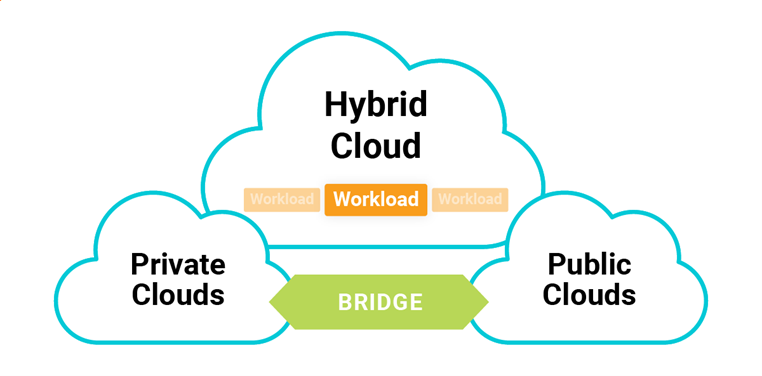Side by side with the popularity of hyperscale
public cloud providers such as AWS and Microsoft Azure, many organizations maintain on-premises data centers. Organizations may keep them for mission-critical
legacy systems with performance demands the cloud cannot meet, or simply be in transition and have not yet migrated their infrastructure to the cloud.
This hybrid cloud model can offer a cost-effective approach, while still taking advantage of the scalability and greater flexibility offered by cloud providers. Understanding the cost savings and benefits of a hybrid cloud model can also help you understand which workloads belong in your data center as opposed to the cloud.
What Exactly Is a Hybrid Cloud?
The term “hybrid cloud” can take on several different definitions but is generally applied to a blend of on-premises and public cloud resources. In practice, the hybrid cloud is typically built with a dedicated private network connection between your data center and your public cloud providers. See Figure 1.

Figure 1: The Hybrid Cloud model.
The Understanding The Pros and Cons of Public Cloud
The public cloud has made it easier to get workloads up and running on-demand, offering automated orchestration to deploy your infrastructure as code and cloud services such as load balancers. Especially for new applications and to gain experience with new services like Kubernetes, the public cloud can give you a good start, along with lower costs of entry for some systems.
However, while cloud services, especially on the lower end of the resource utilization spectrum, are very cost-effective, at higher levels of performance they can be much more expensive than hosting on-premises infrastructure.
When working with clients, one of the most common performance problems I see in the cloud is increased storage latency, which is far greater than the best-in-class storage arrays provide on-premises. In public cloud infrastructure, most storage, whether it be VM storage or object-based storage, is network attached, which typically results in higher latency. Although architects can make optimizations to improve performance, these frequently result in much higher costs while barely approaching the performance of, for instance, an on-premises VMware array running against an all-flash storage array.
Common Use Cases of Hybrid Cloud
Some organizations may choose to keep their on-premises resources under their own management—for example, using VMware to host virtual machines. In recent years, public cloud providers like AWS Outposts and Azure Stack have built on-premises versions of their cloud infrastructure to allow customers to maintain the flexibility and orchestration of the public cloud while maintaining their own computing resources.
Additionally, organizations may run most of their resources in their own data center or private cloud and use public cloud resources only for “bursts” when more compute resources are needed during peak business cycles. A good example of this practice is a retailer that might need additional web servers during the holiday season. Another example would be a firm that uses the public cloud for disaster recovery or takes advantage of cloud storage for archival backups.
Hybrid Cloud Benefits and Limitations
Hybrid cloud solutions can allow customers to take advantage of cloud resources and orchestration even for applications that are running in an on-premises data center.
Another key advantage of using a hybrid cloud model is that your costs can be more predictable because you are not completely at the mercy of your cloud provider’s pricing.
As for limitations of hybrid cloud deployment, one of the largest issues is the sheer complexity of cloud deployment. Complexity starts with networking, which typically requires interaction with both your cloud provider and a telecommunications vendor who supplies the line.
Ensuring your staff is properly trained in your cloud provider and cloud resources is another big challenge in hybrid cloud computing. Obtaining trained, well-qualified engineers is the biggest reason why so many consultants are hesitant to recommend hybrid and multi-cloud deployments—it’s a challenge to find engineers who are well-versed in one cloud, much less two or three.
The Importance of Hybrid Cloud Security
It’s also important to understand cloud security to ensure you are protecting your IT infrastructure. While data security is always a foremost concern, adding a cloud platform to the mix increases your surface area for attack and the potential number of endpoints.
There are a few ways you can protect against these security challenges. A dedicated network connection is a good start. But guarding against misconfigurations—such as leaving open public access to cloud storage that contains sensitive data—can require security testing and tools.
Automation and orchestration, especially with DevOps workflows, can also help minimize the human error factor in deploying cloud resources and supporting your hybrid cloud strategy.
Hybrid Cloud Approach—a Path to Digital Transformation
There can be a number of challenges in monitoring your private cloud, hybrid cloud, and even on-premises workloads. While the cloud may offer some native monitoring solutions, they are often not built to meet the needs of a modern hybrid cloud environment spanning networks, regions, and complex software stacks.
SolarWinds Observability Self-Hosted (formerly known as Hybrid Cloud Observability) is designed to monitor up and down your entire stack to provide deeper, centralized visibility across environments with real-time dashboards and machine learning insights for more intelligent troubleshooting. SolarWinds Observability Self-Hosted (formerly known as Hybrid Cloud Observability) also provides the freedom to deploy to private cloud, public cloud, or even a multi-cloud environment. You can learn more about our
hybrid cloud monitoring features here.
 Figure 1: The Hybrid Cloud model.
Figure 1: The Hybrid Cloud model.




